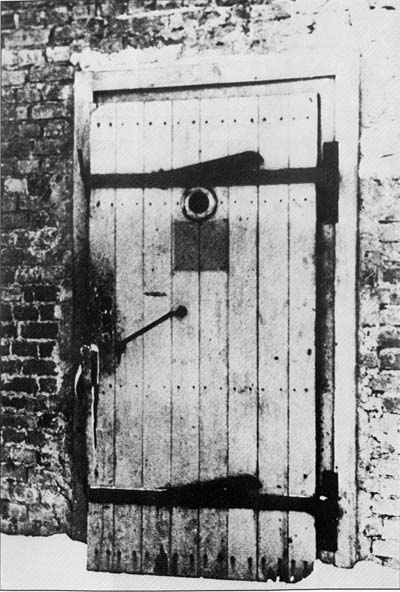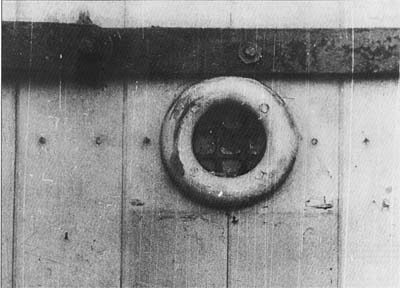
 |
Photo 14: [Soviet Commission 1945, no reference] The gas-tight door of the Kanada I delousing gas chamber. Its construction by the DAW, is very rudimentary. It has a peephole, a handle to open it and two hinged iron bars [latches with handles] to close it, closing being completed by screwing a right-angled bolt through each of the two metal catches into which the latches were fitted.This type of gas-tight door, with the same method of closing, was to be used as it stood in the homicidal gas chambers. |
 |
Photo 15: [PMO neg. No. 621] Close-up of the peephole of the same gas-tight door. |
| Photos 14, 15, 16 and 17 have been deliberately grouped together, for the four of them shown together sum up in striking fashion homicidal gassings using Zyklon B, as the Soviet Commission, the first to undertake investigations on the site in 1945, understood, presented and published them. However, the scene is a completely put up job. It has been common practice to show together a gas-tight door from a delousing gas chamber (having genuinely functioned as such) and an enlargement of its peephole, together with the delousing agent used. Zyklon B. Dating from 1945, this particular presentation is supported by one or two testimonies affirming that a group of Sonderkomtnando men were gassed in this Kanada gas chamber. It is always stated that they were caught “by surprise” but even so, the episode, in the last quarter of 1944, remains dubious. The members of the Sonderkommando that the SS wanted to silence forever because they had seen too much. knew very well how to recognise a gas chamber, and from very far off. In this situation, they would not allow themselves to be shut in like a lot of sheep… This “historic” montage is to he compared with that mentioned in the postface with reference to the Krematorium of K.L. Natsweiler in Alsace. |
|
